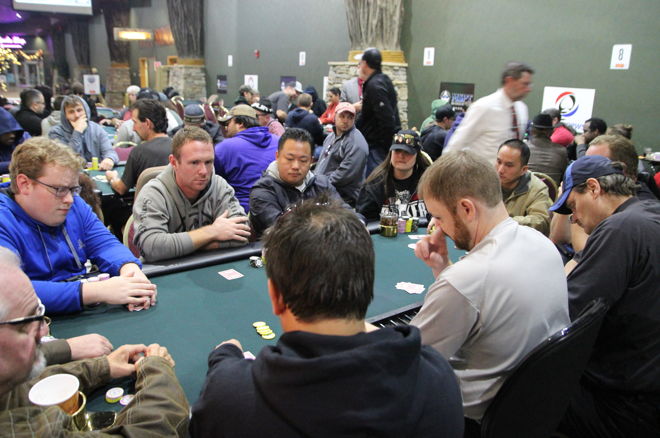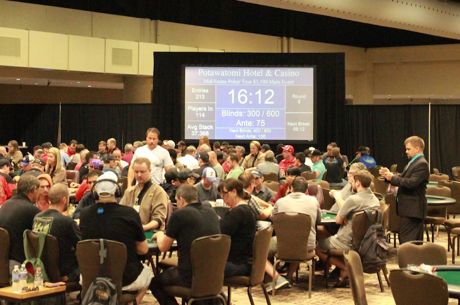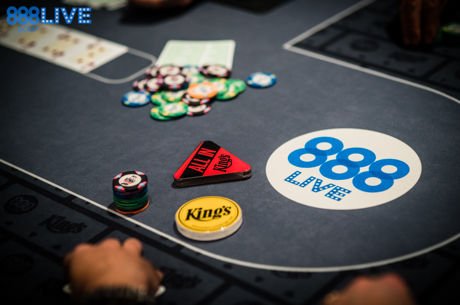Hand Review: Four-Bet Bluff Small or Just Shove?

Covering live poker tournaments for a living affords me the opportunity to see countless thousands of hands played out, many of which offer interesting and potentially valuable insights into how players — both amateurs and professionals — play the game. In this ongoing series, I'll highlight hands I've seen at the tournaments I've covered and see if we can glean anything useful from them.
The Scene
Last week, we looked over a hand I played against a maniac in an event from the World Series of Poker Circuit Potawatomi stop. As I mentioned, the trip was less than successful from a playing perspective, but it sure didn't look like it was going to be that way at first. Today's hand was the start of my weekend-long tailspin, the first bullet I put into the $365 reentry.
Things were going well, as I had run the starting stack of 10,000 up to about 37,000. A player had recently moved into the seat on my right and been fairly active, and I had already established an aggressive dynamic with him by three-betting a couple of his opens. We had just gotten back from break and were at the 300/600/100 level.
The Action
Action folded around to the player in the cutoff, and he opened for 1,400. I looked down at A♥K♥ on the button and reraised to 3,500. After the blinds folded, he shoved all in for about 25,000 and I immediately called. He showed A♣4♣.
The dealer spread a 5x2x4x flop, pairing his four. An Ax came on the turn but the river was a 10x, and I shipped most of my stack to my right.
Concept and Analysis
It's all about stack sizes in this spot.
My opponent in this hand made a standard open with a hand that he should always be opening in the cutoff, A♣4♣. Unfortunately for him, I happened to pick up A♥K♥ on his left.
It's a classic three-betting spot where plenty of players will be reraising light. The player in the cutoff should be opening a lot of hands here. When the player on the button is fairly deep against a cutoff opponent, he or she should usually be calling and reraising a good amount to drive out the blinds and take advantage of position in a heads-up pot.
But again, most players know this. Certainly, this player had to be well aware I was capable of three-betting light since I had already three-bet him twice — once with a good hand and once with 9♥8♥, although he didn't know it.
Thus, my opponent was rightly suspicious and decided to four-bet. I think it's a fine spot to four-bet, given the situation. Where I think my opponent went wrong was on his sizing. With a stack of about 25,000, the cutoff had more than 40 big blinds in his stack to start the hand. He had already opened to 1,400, so he had around 24,000 back facing a bet of 3,500.
Shoving all in here is a massive overbet. His hand is going be dominated 100 percent of the time when he gets called. Given the fact that I had three-bet him twice already, I knew he was likely going to fight back soon, so I was ready to get it in a little lighter than normal. I wouldn't be folding any decent pair, AxKx or AxQx. I might go with AxJx even. That's a good portion of my three-betting range.
Certainly he gets some hands like KxQx that have good equity against him to fold. He even gets me to fold some dominating stuff with which I might be three-betting light like Ax8x.
But there's plenty of money behind for him to make a four-bet to something like 8,500. Yes, this would give me the chance to five-bet bluff all in and he'd have to fold. But in that case, he'd still have almost 30 big blinds and plenty of play left.
Being aware of stack sizes is critical when deciding on preflop plays. Jamming in on a four-bet with A♣4♣ would be perfectly fine with about 25 big blinds here against some very aggressive opponents. In fact, it's probably a positive expectation play.
Having over 40 big blinds, though, means you have room to maneuver. It's okay to four-bet bluff and fold at this depth. And, if you have a good hand, you don't want to be shoving in this many chips, as it lets opponents off the hook, giving them a chance to make tight folds and just give up a small pot.
I have to give my opponent credit for one thing at least. He didn't waste this beat, as I believe he advanced to the final table of the 1,200-plus player field.









